Best Time to Post on LinkedIn in 2025: 8 Data-Driven Tips
Master LinkedIn timing with 8 data-driven tips. Learn when to post for maximum reach, engagement, and professional impact.
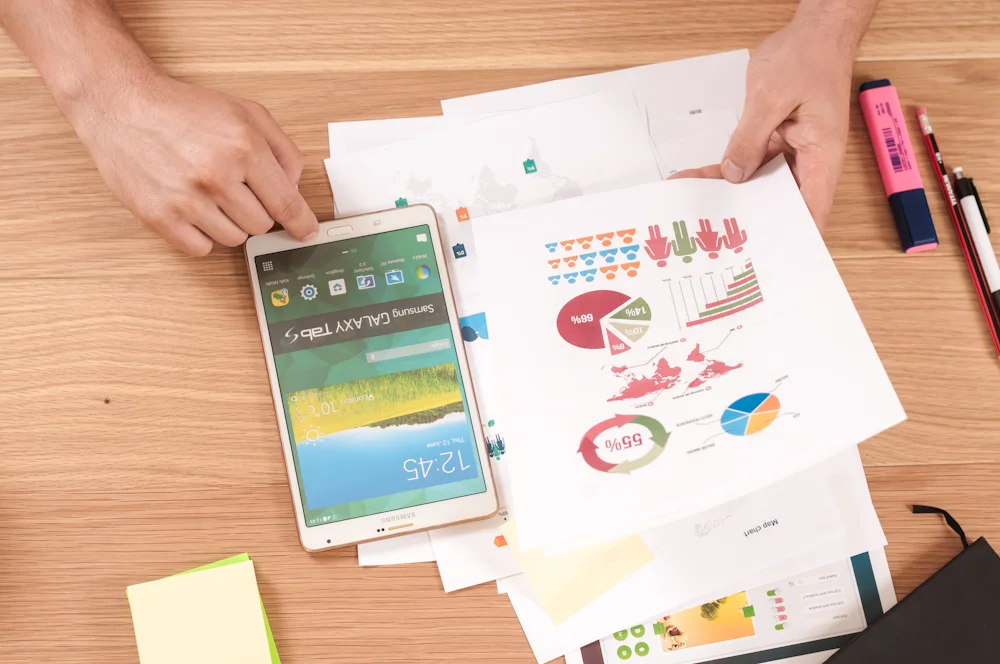
Best Time to Post on LinkedIn in 2025: 8 Data-Driven Tips
In the crowded world of professional networking, timing isn't just a factor, it's the key to visibility. The LinkedIn algorithm heavily favors content that sparks immediate engagement, and posting at the right moment can mean the difference between a post that trends and one that vanishes into the feed. But generic advice often falls short. The true best time to post on LinkedIn isn't a single magic hour; it's a strategic approach tailored specifically to your audience, industry, and professional goals.
This guide moves beyond the basics to provide eight data-driven strategies that reveal precisely when your target audience is most receptive and ready to engage. By mastering these principles, you'll not only amplify your reach but also build more meaningful connections, one perfectly timed post at a time. We'll explore peak business hours, the critical first 'golden hour' after publishing, and how to use LinkedIn's own analytics to create a personalized posting schedule that delivers consistent results. This isn't just about getting more views; it's about making every post count.
1. Post During Peak Business Hours (8-10 AM and 12-2 PM)
The most consistently effective strategy for determining the best time to post on LinkedIn is to align your schedule with the professional workday. Unlike other social networks used during leisure time, LinkedIn is primarily a platform for business professionals. They are most active during specific windows: the start of their day as they settle in and the midday break when they catch up on industry news.
Posting between 8-10 AM and 12-2 PM on weekdays places your content directly in front of your audience when their engagement is at its peak. Think of these as the "prime time" slots for professional networking. Users are actively checking notifications, scrolling their feeds for updates, and engaging with content before diving into their core tasks or while taking a lunch break. This approach is foundational and validated by extensive research from industry leaders like Hootsuite and Buffer.
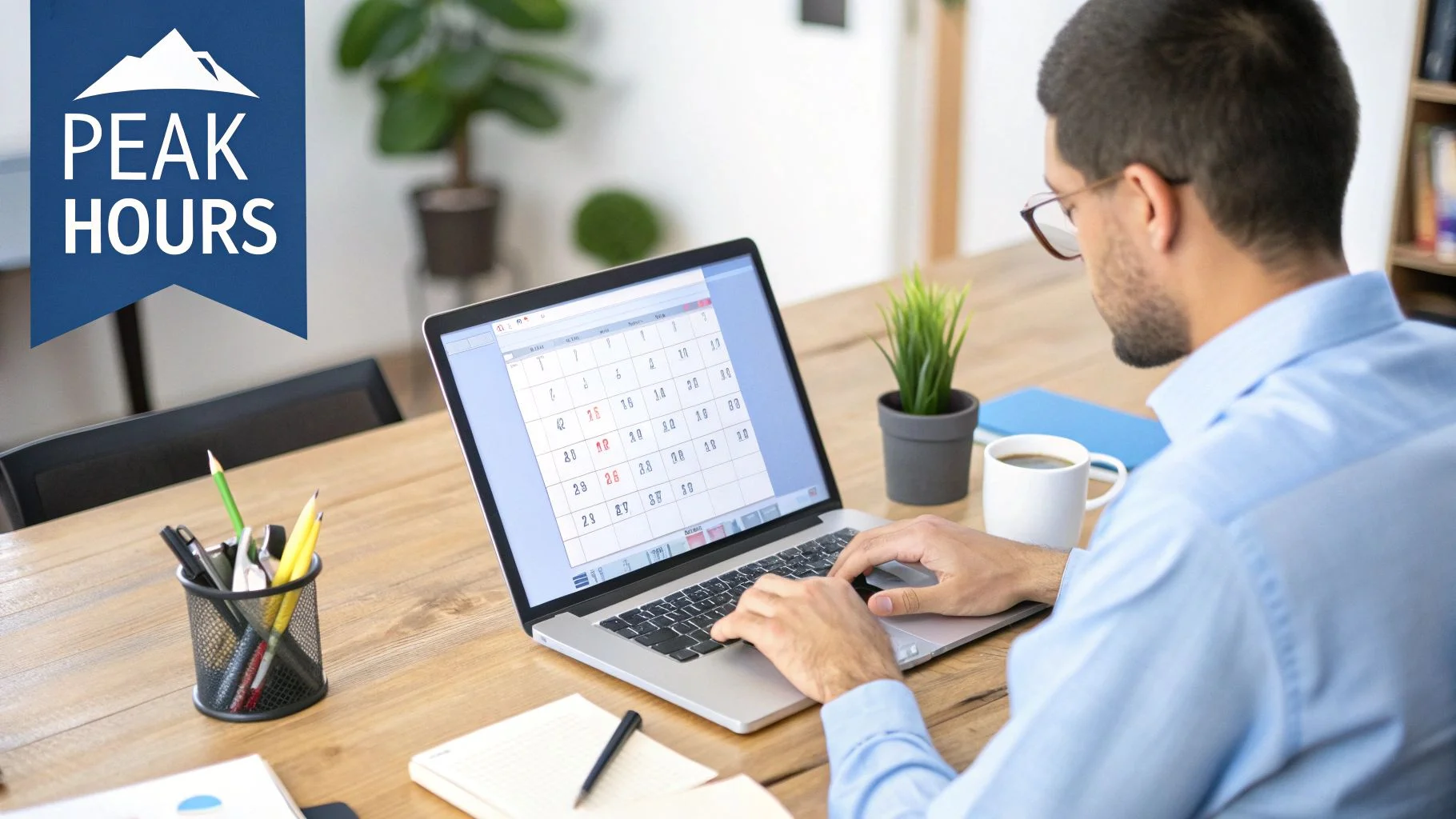
Why This Timing Works
The logic is simple: presence equals engagement. By publishing content when the highest volume of users is online, you maximize its initial visibility. LinkedIn's algorithm favors posts that gain early traction (likes, comments, and shares), which then boosts them to a wider audience. Capturing this initial wave of engagement is crucial for achieving sustained reach.
For example, HubSpot has noted that its 9 AM posts often see a 40% higher engagement rate compared to other times. Similarly, Buffer’s internal data highlights that the 8-10 AM window generates 45% more clicks, confirming that these early morning hours are a goldmine for driving traffic and interaction. For more in-depth data on how to leverage these peak windows, check out this detailed guide on posting times.
How to Implement This Strategy
To effectively leverage peak business hours, follow these actionable steps:
Consider Time Zones: Don't just post based on your local time. If your target audience is nationwide or global, schedule content for the peak hours in their primary time zones. For a US audience, this might mean posting at 8 AM EST to catch the East Coast and repeating it at 8 AM PST for the West Coast.
Test Both Slots: Don't assume one window is universally better. Run A/B tests by posting similar content in the 8-10 AM slot one week and the 12-2 PM slot the next. Use your LinkedIn Analytics to see which time consistently delivers more views and engagement for your audience.
Schedule in Advance: Use a scheduling tool to post 15-30 minutes before the absolute peak (e.g., 7:45 AM or 11:45 AM). This ensures your content is already live and ready to be seen by the earliest browsers, giving it a head start.
2. Focus on Tuesday Through Thursday for Maximum Reach
Beyond specific hours, the day of the week you post is a critical factor in determining your content's reach. While weekdays are generally better than weekends, the mid-week period from Tuesday to Thursday consistently emerges as the professional "sweet spot." Mondays are often spent catching up on emails and planning, while Fridays see attention shift towards wrapping up tasks and the upcoming weekend, leading to lower engagement.
The core of this strategy, supported by extensive data from industry leaders like Sprout Social and LinkedIn's own marketing team, is to publish your most valuable content when your audience is most focused and receptive. Tuesday through Thursday are the days when professionals are fully immersed in their workweek, actively seeking industry insights, and most likely to interact with business-related content.
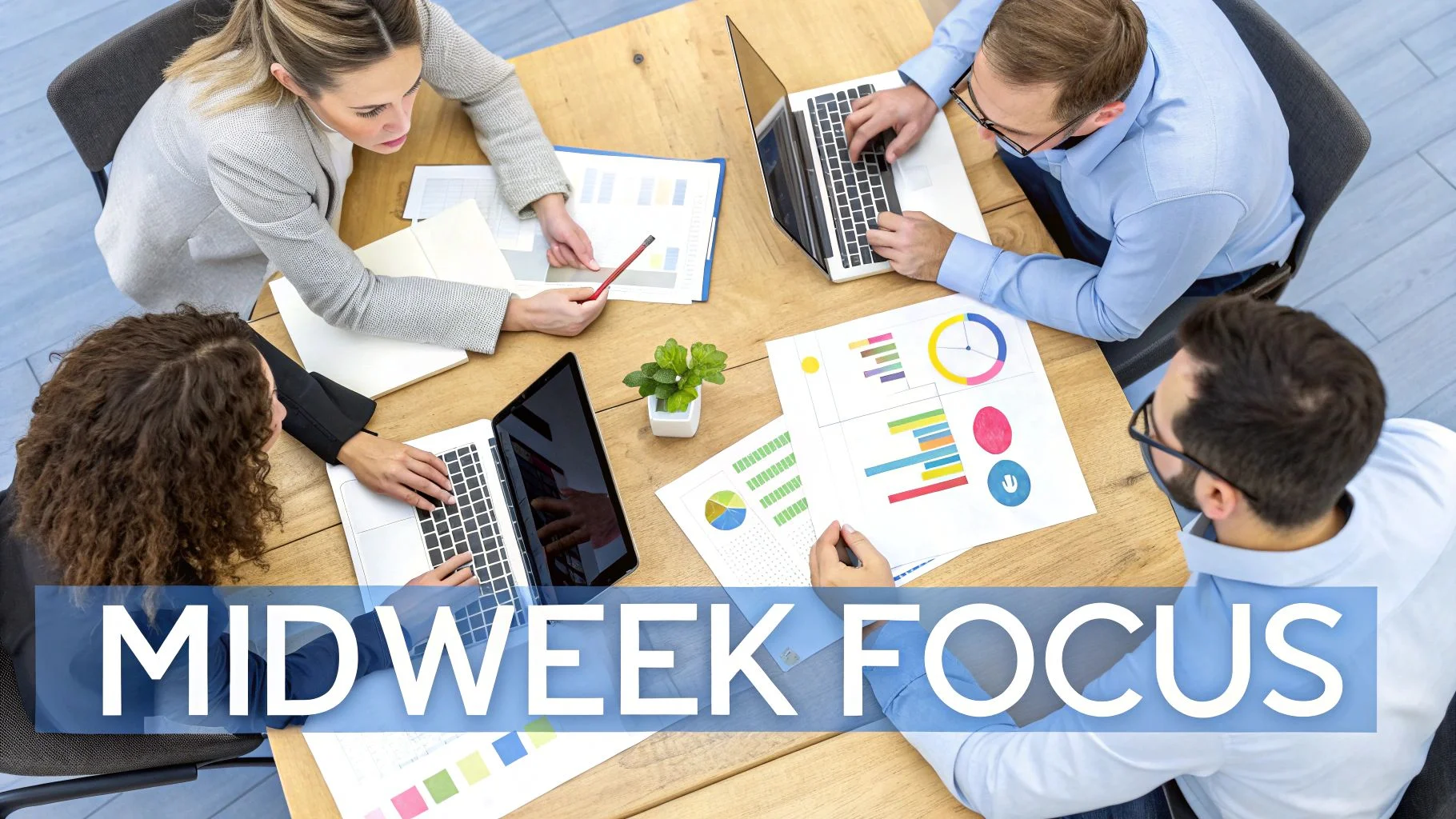
Why This Timing Works
Mid-week days represent peak professional momentum. By Tuesday, the initial chaos of Monday has subsided, and professionals are settled into their routines. This state of focused productivity makes them more inclined to engage with thought leadership, industry analysis, and career-related posts. The algorithm rewards this concentrated engagement, giving mid-week posts a significant advantage in visibility.
For instance, Microsoft has reported that its Tuesday posts on LinkedIn often receive up to 60% more engagement than those published on Mondays. Similarly, Deloitte consistently sees its highest click-through rates on content shared on Wednesday afternoons, confirming that these mid-week windows are optimal for driving action. CoSchedule's research further solidifies this, naming Tuesday the top day for B2B engagement.
How to Implement This Strategy
To harness the power of the mid-week sweet spot, adopt a strategic approach to your content calendar:
Plan Your Most Important Content: Reserve your most impactful posts, such as company announcements, in-depth articles, or major case studies, for Tuesday, Wednesday, or Thursday to maximize their reach and impact.
Use a Thematic Approach: Designate specific content types for each day. Use Monday for lighter, motivational posts to ease into the week. Save Fridays for company culture highlights, team spotlights, or more casual end-of-week reflections.
Batch Create for Consistency: To avoid the mid-week rush, batch-create your Tuesday-Thursday content in advance. This ensures you maintain a consistent posting schedule without sacrificing quality, which is crucial for building audience expectations.
3. Leverage the 'Golden Hour' - First Hour After Posting
While choosing the right time window is important, what you do immediately after publishing is equally critical to your success. LinkedIn's algorithm heavily prioritizes posts that generate immediate engagement. This "Golden Hour," the first 60 minutes after your content goes live, is the most crucial period for signaling to the platform that your post is valuable and worth distributing to a wider audience.
Initial likes, comments, and shares act as powerful social proof, telling the algorithm to push your content beyond your immediate network. This strategy focuses less on a specific time of day and more on the immediate post-publication actions that create momentum. It's a proactive approach to content distribution popularized by social media experts like Gary Vaynerchuk, whose team actively engages within minutes of posting to maximize reach.
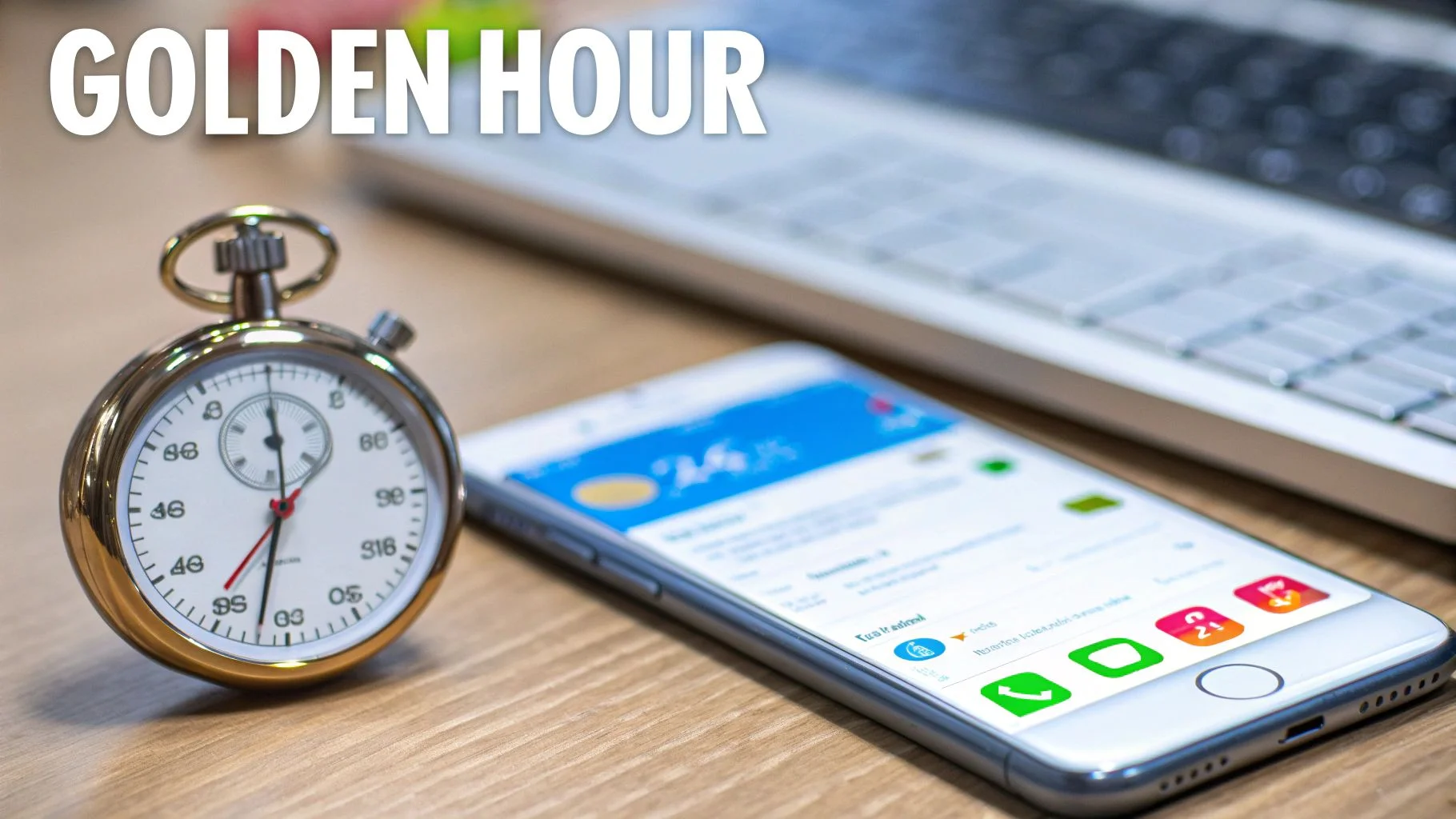
Why This Timing Works
The logic behind the Golden Hour is based on algorithmic momentum. A post that sits idle with zero engagement is quickly deprioritized. Conversely, a post that sparks conversation right away is flagged as high-quality content. This initial burst of activity creates a snowball effect, ensuring your post appears in more feeds and gains sustained visibility long after that first hour.
For example, Adobe's social media team reportedly sees up to 300% better performance on posts where they respond to all comments within the first hour. Similarly, LinkedIn founder Reid Hoffman's posts consistently trend because his team employs a first-hour engagement strategy to kickstart dialogue. This proves that an active presence is key to determining the best time to post on LinkedIn, as it amplifies the impact of any time slot you choose. You can explore how to maximize this initial momentum by learning more about improving your LinkedIn reach.
How to Implement This Strategy
To effectively leverage the Golden Hour, follow these actionable steps:
Stay Online and Engage: Do not post and ghost. Plan to be actively on LinkedIn for at least 30-60 minutes after your content is published. Your immediate availability is non-negotiable for this strategy to work.
Respond to Every Comment: Acknowledge every single comment with a thoughtful reply, not just a "like." Ask follow-up questions to encourage further discussion and keep the conversation going.
Notify Your Team: Create an internal alert system (e.g., a Slack channel) to notify colleagues as soon as a post goes live. A few early likes and comments from your team can provide the initial spark needed to get the algorithm's attention.
Share in Relevant Groups: Immediately after publishing, share your post in 2-3 relevant and active LinkedIn Groups. Frame it with a question to encourage members to click through and join the conversation on your original post.
4. Understand Your Audience's Geographic Time Zones
While posting during general peak hours is a great start, a truly optimized strategy accounts for where your audience actually lives and works. If your network and target market span different countries or continents, posting only in your local time zone means a large portion of your audience will miss your content. The best time to post on LinkedIn for a global audience is not a single time but a series of coordinated times.
Understanding your audience's primary geographic locations allows you to schedule content when they are most active. This approach moves beyond generic advice and tailors your publishing schedule to the specific daily routines of your most valuable connections. Global marketing teams and international consultants have long used this strategy to ensure consistent engagement across diverse markets, recognizing that a 9 AM post in New York is a 2 PM post in London and a 9 PM post in Singapore.
Why This Timing Works
The effectiveness of this strategy lies in its precision. By targeting specific time zones, you ensure your content appears at the top of your audience's feed during their peak business hours, no matter where they are. This localization dramatically increases the likelihood of initial engagement, which is a critical signal to the LinkedIn algorithm to boost your post's reach. A well-timed post for a European audience can gather momentum while your US audience is still asleep.
For example, a company like Zoom might schedule a major product announcement for 10 AM GMT. This time strategically catches the European market mid-morning, the East Coast of the US just starting their day, and even late-afternoon professionals in parts of Asia. This maximizes initial global visibility and generates a worldwide conversation.
How to Implement This Strategy
To effectively leverage a multi-timezone strategy, follow these actionable steps:
Analyze Your Follower Demographics: Navigate to your LinkedIn Page's analytics section and review the "Follower demographics." This will show you the top countries and cities where your audience is located. Prioritize the top 3-5 locations.
Create a Multi-Time Zone Schedule: Use a social media scheduling tool that allows for multi-time zone planning. Schedule key posts to go live during the 8-10 AM peak window in each of your primary geographic regions.
Focus on Your Most Valuable Markets: You don't need to cover every time zone. Identify where your most important clients, prospects, or industry peers are located and concentrate your scheduling efforts there. If your goal is to expand in Europe, prioritize GMT and CET.
Test and Refine: Experiment by posting at different times to hit various regions. For instance, post at 6 AM EST to reach audiences in the UK and Europe as their workday begins, and then monitor your analytics to see which posts perform best in those areas.
5. Test and Analyze Your Own Data Rather Than Following Generic Advice
While industry benchmarks provide an excellent starting point, the most powerful strategy for finding the best time to post on LinkedIn is to treat them as hypotheses, not rules. Every audience is unique, with distinct professional habits, industry norms, and time zone concentrations. The ultimate truth lies within your own data, and relying solely on generic advice means you could be missing your specific audience's peak engagement window.
This approach involves systematically testing various posting times and meticulously analyzing the results through LinkedIn's native analytics. By moving beyond one-size-fits-all recommendations, you can uncover the precise moments your network is most receptive to your content. This data-driven method is championed by top marketing consultants and analytics firms as the definitive way to optimize your LinkedIn presence for maximum impact.
Why This Timing Works
The logic behind this strategy is that your audience's behavior is the only metric that truly matters. Generic data aggregates millions of users, but it doesn't account for the specific nuances of your target demographic. For instance, Mailchimp discovered their audience engaged 40% more at 6 PM, well outside traditional business hours. Similarly, Canva found their creative professional audience preferred 7 AM posts over the more common lunch-time slots.
By analyzing your own performance, you can identify patterns unique to your followers. Shopify's B2B content, for example, performs best at 3 PM, defying the standard morning recommendations. These outliers demonstrate that the absolute best time to post on LinkedIn is highly personal, and a commitment to testing is the only way to uncover it.
How to Implement This Strategy
To effectively analyze your own data and find your custom posting times, follow these actionable steps:
Commit to a Testing Period: Don't draw conclusions from a single post. Test different days and times consistently for at least 4-6 weeks to gather a reliable dataset that accounts for weekly fluctuations.
Track the Right Metrics: Go beyond vanity metrics like likes. Focus on the engagement rate (total engagements divided by total impressions) and click-through rate to understand what truly resonates. Document your findings in a simple spreadsheet.
Use Native Analytics: LinkedIn's own analytics tool is your most accurate source of truth. Navigate to your post analytics to see impressions, clicks, and engagement data for each piece of content. This will help you connect specific times with specific results.
Establish a Baseline and Iterate: Start by posting during the widely recommended peak hours. Use that performance as your baseline. Then, experiment with non-traditional times (e.g., evenings, early mornings, weekends) and compare the results. Update your posting schedule quarterly based on your findings.
6. Avoid Weekend Posting for Professional Content
While platforms like Instagram and Facebook see engagement spikes on weekends, LinkedIn operates on a different rhythm. As a professional network, its user activity is intrinsically tied to the workweek. Posting on Saturdays and Sundays often means your content gets lost in the quiet, as most users have logged off to focus on personal time.
Data consistently shows that engagement plummets on weekends, with posts typically receiving 60-80% fewer interactions than those published on weekdays. When determining the best time to post on LinkedIn, understanding when your audience is not active is just as critical as knowing when they are. Weekends are generally a dead zone for B2B content, making them an ineffective choice for reaching your target professional audience.
Why This Timing Works
The logic is straightforward: professionals disengage from work-related platforms during their downtime. LinkedIn's official usage statistics and reports from social media marketing firms confirm a dramatic drop in active users from Friday evening until Monday morning. Your carefully crafted thought leadership article or company update is unlikely to gain traction when your audience is focused on family, hobbies, and relaxation.
For example, major consulting firms like Ernst & Young often see their weekend posts get up to 75% fewer interactions compared to their weekday content. Even high-profile figures with massive followings experience this dip; professional announcements made on a Saturday simply don't generate the same level of discussion. Saving your best content for a weekday ensures it lands in front of an active, engaged professional mindset.
How to Implement This Strategy
Instead of posting, use the weekend strategically to prepare for the week ahead. Here are actionable steps to follow:
Shift Focus to Content Creation: Use your weekend hours for planning and creating high-quality content. This allows you to have a polished post ready for peak engagement times, like Monday or Tuesday morning, without rushing.
Schedule for Monday Morning: If an idea strikes you over the weekend, don't post it immediately. Instead, use a scheduling tool to queue it for Monday morning between 8-10 AM. This ensures it launches when your audience is returning to work and catching up.
Engage, Don't Broadcast: Weekends can be a great time to build relationships. Instead of posting your own content, spend 15-20 minutes engaging with posts in your feed. Leaving thoughtful comments can build goodwill and increase your visibility for the upcoming week.
Consider Lighter Content (If You Must Post): If you have a compelling reason to post, stick to inspirational stories, personal reflections, or professional development themes. Avoid hard-hitting business analytics or promotional content that demands a work-focused mindset.
7. Consider Industry-Specific Timing Variations
Moving beyond one-size-fits-all advice, one of the most sophisticated strategies is to tailor your posting schedule to the unique rhythms of your specific industry. Different professions operate on distinct schedules, meaning their peak LinkedIn activity doesn't always align with standard 9-to-5 business hours. Acknowledging these nuances is key to finding the absolute best time to post on LinkedIn for your niche audience.
Professionals in healthcare, finance, and education, for example, have workdays that defy traditional corporate structures. A nurse working a 12-hour shift will check LinkedIn at different times than a financial analyst who starts before the market opens. By aligning your content with these industry-specific windows, you can capture attention when your competitors, who are using generic timing, are silent. This targeted approach demonstrates a deeper understanding of your audience and their daily routines.
The bar chart below visualizes the distinct peak engagement times for professionals in Healthcare, Financial Services, and Education, illustrating how drastically optimal timing can vary.
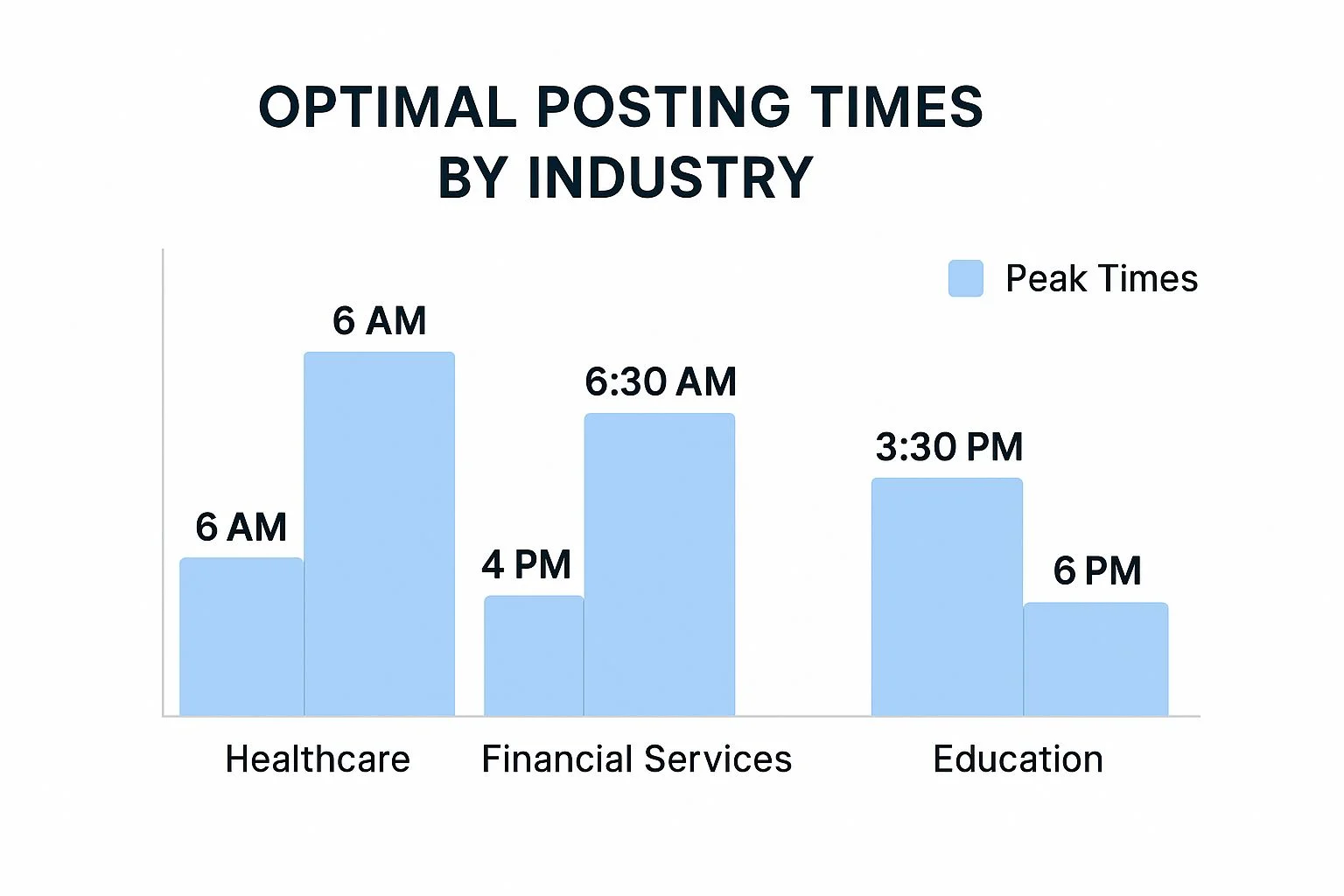
This data clearly shows that posting at a generic peak time like 9 AM would completely miss the most active windows for these specific professional groups.
Why This Timing Works
The effectiveness of this strategy lies in its hyper-relevance. When you post content aligned with an industry's specific workflow, you reach professionals during their natural downtime or moments of transition. A teacher is more likely to engage with content after school lets out, just as a restaurant manager is more active late at night after service. This precision targeting results in higher engagement because your content appears at the most convenient time for your audience to consume it.
For instance, a medical device company might see a surge in engagement by posting at 6 AM, catching healthcare workers before their shifts begin. Similarly, an EdTech firm could achieve greater reach by scheduling posts for 3:30 PM, targeting educators as their school day ends. This is a powerful method used by vertical SaaS companies and professional associations to maximize their content's impact. For more insights on how small businesses can leverage niche strategies, explore this guide on industry-specific marketing.
How to Implement This Strategy
To successfully apply industry-specific timing, follow these steps:
Research Your Industry’s Rhythm: Analyze the typical workday in your target sector. Do they work early mornings, late nights, or standard hours? Consider factors like shift changes, market opening times, or seasonal demands.
Observe Industry Influencers: Follow key leaders and companies in your niche. Use their posting times as a benchmark and note when their content receives the most engagement. This provides real-world data on what works.
Leverage LinkedIn Groups: Join industry-specific LinkedIn groups and observe when discussions are most active. This is a direct line to understanding when your target audience is online and ready to engage.
Test and Validate: Formulate a hypothesis (e.g., "Educators are most active at 3:30 PM") and test it by scheduling posts for that specific time. Use your analytics to compare the performance against posts at general peak hours.
8. Use LinkedIn's Native Scheduling Tool with Strategic Timing
One of the most effective and often overlooked tactics for optimizing your posting schedule is to use LinkedIn’s own built-in scheduling feature. While third-party tools offer convenience across multiple platforms, LinkedIn's algorithm often gives preferential treatment to content scheduled and published directly through its native system. This seamless integration ensures your posts are processed and distributed without potential API-related delays or formatting issues.
Using the native scheduler allows you to precisely target the best time to post on LinkedIn for your specific audience while signaling to the platform that the content is original and prioritized. It’s a simple change that can yield significant improvements in initial reach and engagement, as the content is perfectly aligned with LinkedIn’s internal publishing mechanisms from the start.
Why This Timing Works
The logic behind this strategy is rooted in platform preference. Social media platforms, including LinkedIn, are designed to keep users within their ecosystem. By using the native scheduling tool, you are operating entirely within LinkedIn's environment, which can lead to a subtle but impactful algorithmic advantage. The system can better analyze, categorize, and push your content to relevant feeds.
For instance, many B2B marketing experts report a 15-20% improvement in organic reach when switching from third-party schedulers to the native tool for their most important announcements. This is because the post enters the distribution queue immediately and correctly, maximizing its potential to capture early engagement during your chosen peak hours.
How to Implement This Strategy
To leverage LinkedIn's native scheduler for optimal timing, follow these actionable steps:
Plan Ahead (But Not Too Far): Schedule your key posts 24-48 hours in advance. This gives the system ample time to process the content while keeping it recent enough to be treated as timely and relevant by the algorithm.
Prioritize High-Value Content: Use the native scheduler for your most critical content, such as company announcements, thought leadership articles, or major product updates. For less critical, everyday posts, a third-party tool might still be efficient.
Combine with Immediate Engagement: Natively scheduled posts are not a "set it and forget it" tool. Be ready to engage with comments and questions within the first hour after the post goes live. This immediate interaction is a powerful signal to the algorithm to boost your content further.
Verify Publication: Always double-check your profile or company page at the scheduled time to ensure the post was published correctly without any errors. While reliable, it's always best to confirm.
Best Time to Post on LinkedIn: 8-Point Strategy Comparison
| Strategy | Implementation Complexity 🔄 | Resource Requirements ⚡ | Expected Outcomes 📊 | Ideal Use Cases 💡 | Key Advantages ⭐ |
|---|---|---|---|---|---|
| Post During Peak Business Hours (8-10 AM and 12-2 PM) | Medium – Scheduling at set windows | Low – Basic scheduling tools | High immediate engagement | Broad professional audiences | Consistent high visibility; easy to implement |
| Focus on Tuesday Through Thursday for Maximum Reach | Medium – Consistent mid-week posts | Medium – Regular content planning | 25-45% higher mid-week engagement | B2B and professional content | Leverages professional mindset at peak engagement |
| Leverage the 'Golden Hour' - First Hour After Posting | High – Requires active monitoring | High – Real-time engagement effort | Dramatic organic reach boost | Time-sensitive posts needing viral momentum | Algorithmic priority on early engagement |
| Understand Your Audience's Geographic Time Zones | High – Complex multi-zone planning | High – Analytics and multiple schedules | Optimized reach across global markets | Global brands or multi-region audiences | Maximizes relevance and ROI in international markets |
| Test and Analyze Your Own Data Rather Than Following Generic Advice | High – Data collection and analysis | Medium-High – Analytics tools and time | Tailored optimized posting strategy | Unique or niche audiences | Customized insight; better long-term strategy |
| Avoid Weekend Posting for Professional Content | Low – Simple scheduling choice | Low – Minimal weekend activity | 60-80% lower engagement on weekends | Professional, B2B, and business-centered posts | Focus resources on high-engagement periods |
| Consider Industry-Specific Timing Variations | High – Industry research needed | Medium-High – Sector-specific analysis | Better alignment with industry behaviors | Industry-targeted content strategy | Competitive advantage via niche timing |
| Use LinkedIn's Native Scheduling Tool with Strategic Timing | Low – Use integrated platform tool | Low – LinkedIn account only | 15-20% better reach vs. third-party tools | Users prioritizing platform-native tools | Seamless integration; better algorithm compatibility |
From Timing to Transformation: Your Action Plan for LinkedIn Success
Finding the best time to post on LinkedIn is more than just a scheduling hack; it's a strategic amplifier for your content. As we've explored, the data points towards a clear pattern: professional audiences are most active during the business week, particularly from Tuesday through Thursday. Targeting the morning commute (8-10 AM) and lunch break (12-2 PM) windows gives your content the best possible launchpad for visibility and engagement.
However, treating these time slots as a rigid, one-size-fits-all solution is a mistake. The real power comes from using these data-driven insights as your starting point, not your final destination. True mastery lies in a continuous cycle of testing, analyzing your unique audience data, and refining your approach. Generic advice gets you in the game, but personalized data helps you win.
Your Path from Data to Dominance
The core lesson is that timing is the catalyst, not the entire chemical reaction. An average post at the perfect time will still underperform compared to a phenomenal post at a good time. Your ultimate goal is to align three critical elements:
Intelligent Timing: Use the peak hours we've discussed as your initial test beds. Adjust for your audience's specific time zones and be mindful of industry-specific nuances that might shift engagement patterns.
High-Value Content: Your posts must be relevant, insightful, and valuable to your target audience. Whether it's a unique perspective, a helpful tip, or a compelling story, the quality of your content is what earns the click, the comment, and the share.
Consistent Engagement: Posting and ghosting is a recipe for failure. The "golden hour" immediately after you post is your prime opportunity to spark conversations by responding to comments and engaging with others. This signals to the LinkedIn algorithm that your content is valuable, boosting its reach.
By integrating these three pillars, you move beyond simply posting and start building a powerful professional brand. You transform your LinkedIn presence from a passive resume into an active, dynamic platform for networking, lead generation, and career growth. The right timing ensures your voice is heard, but the quality of your content and your commitment to engagement are what will make people listen.
Ready to turn these timing strategies into effortless, consistent results? Social Presence helps you capitalize on that critical "golden hour" by curating your feed and offering AI-assisted comments you can personalize to stay authentic. Stop guessing and start engaging intelligently. Try Social Presence today and make every post count.
Article created using Outrank